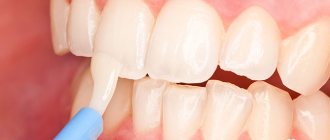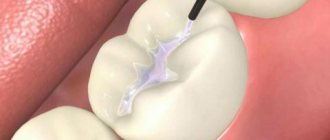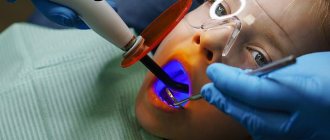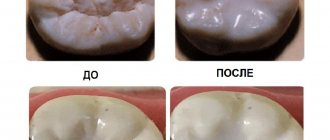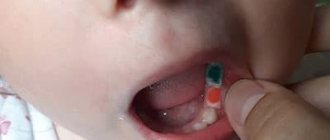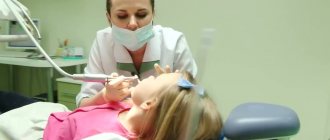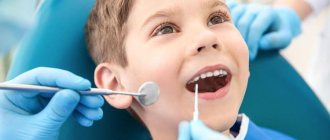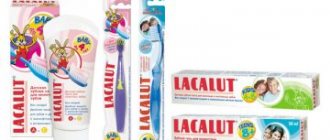Prevention of caries in children is an important point in maintaining the health of a still fragile body. Proper nutrition and care of temporary and permanent teeth are the main components of the correct approach to solving this problem.
Why is caries prevention needed in children if temporary teeth will soon be replaced by permanent ones? As practice shows, a set of timely preventive measures reduces the risk of infection of permanent teeth in children and adolescents by 80%!
Stopping the development of caries
It is advisable to stop the development of caries at the earliest possible stage: in this case, the disease will be much easier to treat.
At the initial stage, caries looks like a small spot. At this stage of development, it can be coated with a special gel that can restore damaged enamel. If you see a doctor on time, you may be able to do without the preparation procedure, which is, of course, completely painless.
If you start the development of caries, you will have to resort to drilling, and if the pulp is affected, this can add additional painful sensations.
In addition, ignoring caries is fraught with:
- destruction of the affected tooth and, as a result, expensive installation of an implant;
- indigestion, since the affected teeth cannot fully cope with the chewing function;
- aesthetic inconveniences.
Prevention of caries: local methods
These methods of preventing caries include:
- Remineralization is a procedure during which tooth enamel is saturated with fluoride and calcium, which has a positive effect on its strength. In addition, fluoride prophylaxis increases the resistance of enamel to microorganisms that provoke the development of caries.
When acidity drops below pH5, the concentration of calcium and a number of other elements in tooth enamel begins to rapidly decrease. It is at this moment that the greatest activity of cariogenic organisms is observed. After covering the tooth surface with fluoride varnish, fluorine begins to penetrate into the enamel, which, together with calcium, does not allow it to dissolve even in conditions of high acidity.
Remineralization can be:
- Homemade, which consists of the most ordinary thorough brushing of teeth with toothpastes containing fluoride. There are pastes with more effective amino fluoride (they have a higher price and a faster penetration rate of fluoride into the enamel), as well as with sodium monofluorophosphate (they are a budget option). For a more professional fluoride prophylactic course, in addition to toothpastes and rinses, you will need remineralizing gels, which need to be used every 3-4 months, which does not replace brushing your teeth. If you follow these rules throughout your life, there's a good chance you'll never have to treat tooth decay.
- Professional , for which you cannot do without visiting a doctor. Its main advantage is better efficiency due to the use of drugs characterized by a higher concentration of active substances. During the procedure, the teeth are coated with a transparent fluoride-containing varnish, which actively penetrates the enamel over the course of several hours. Gradually the film dissolves.
WHO recommends fluoride prophylaxis in two ways: using fluoride pastes at home and periodically resorting to the use of professional preparations that modern dentistry can offer.
- Proper oral hygiene , which is both a simple and very important step in caries prevention, prevents the appearance of carious areas.
A considerable part of people believe that their oral hygiene is absolutely fine. However, if this were true, the disease would not be so common.
When does prevention begin?
The rudiments of future teeth in the fetus are formed in the womb. At this time, it is important for a woman to monitor her health very carefully. You should exclude excess sweets from your diet (especially pure sugar). If medications are required, a doctor should prescribe them and monitor side effects. Some modern medications have a detrimental effect on the formation of teeth, which subsequently affects the color of the enamel and its structure.
The enamel layer of newborn teeth is very thin, and the gum tissue is dotted with blood vessels. This is the main reason why the process of teething in babies is so painful. At this time, parents should be sure to brush their children’s teeth with toothpastes of category 0+, and to relieve pain, use children’s anti-inflammatory drugs as recommended by the dentist.
How to prevent tooth decay
- Regular brushing of teeth (preferably after every meal). Moreover, you should brush your teeth not an hour or two, but within 5 minutes after eating. It has been proven that food debris and pathogens cause maximum harm to teeth in the first 40 minutes. Is it necessary to brush your teeth after every meal, that is, even after a light snack or tea with candy? Yes, it is necessary, and you need to clearly understand this for yourself. Therefore, you should not overuse snacks during the day.
- Dental floss - This is not an additional tool for cleaning the oral cavity, but is as basic as a toothbrush. Floss must be used in the same way after each meal. For a person who has never used floss before, it may be difficult to understand how to use it - a dentist can help with this. The task of dental floss is to remove food debris between the teeth (caries, no less rarely, develops not only in the tooth cavity, but also between two adjacent teeth).
- What to do if brushing your teeth is problematic (for example, in a cafe or outdoors)? You should always have dental floss or, as a last resort, chewing gum with you. A package of thread does not take up much space, and you can use it by going to the toilet (if we are talking about a room) or stepping aside. Many people are embarrassed to behave this way, as a result, subsequently they will not always have simple and cheap treatment for caries. Embarrassment is inappropriate here: there is nothing shameful in getting up and going to the restroom for a couple of minutes. It’s much better to breathe in freshness afterwards, rather than “delight” those around you with the aromas of a recently eaten lunch.
- Food debris often accumulates under dentures and braces.. People who have crowns in their mouths can be advised to use an irrigator - a device that delivers a stream of water through a special nozzle, saturated with air bubbles and washing away food debris. The device is especially effective for gingivitis and periodontitis, when pockets form where a large number of microbes accumulate. Periodontal pockets are very difficult to clean with a brush or floss, but an irrigator can cope with this task perfectly. The device is also recommended for pregnant women, who often suffer from gingivitis.
In addition to brushing and flossing, the following can help prevent tooth decay:
- strengthening the immune system. A weakened body is not able to fully resist the effects of bacteria. To minimize the risk of developing caries, subject to good hygiene, you need to take care of your immunity through the use of vitamins and hardening;
- properly formulated diet. First of all, you need to reduce the consumption of simple carbohydrates, and also increase the amount of foods containing fluoride and calcium in the menu. We must not forget about regular consumption of hard fruits and vegetables, which cleanse teeth of plaque.
It hasn't started yet
By the age of three, children have a full set of 20 baby teeth. And all kinds of sweets begin to appear in the children's diet, which provokes the appearance of the first “holes” (cavities) in the teeth. Doctors today are trying to treat such caries using innovative technologies without preparation (without using a drill), which creates the most comfortable conditions for children.
Among the popular methods:
ICON is a new, safe technology for the treatment of caries at the initial stage without preparation. Hard tooth tissues are treated with a specially developed chemical preparation, which, entering the capillaries of enamel and dentin, prevents the spread of caries.
Ozonation is a method of treating caries of primary teeth using ozone. It is considered the most reliable and effective way to protect children's teeth from decay. This painless method allows you to disinfect affected tissues using ozone molecules and destroy all cariogenic microorganisms in the diseased tooth.
Professional mechanical teeth cleaning Air Flow (air-kinetic treatment) is a silent process of non-contact treatment of carious cavities using air flow. The surface of the teeth is treated under pressure with an aerosol jet that contains water, air and abrasive powder based on sodium bicarbonate (soda), after which the tooth enamel is fluoridated.
Avoid losses. What dental diseases are important to cure immediately? Read more
Caries: general methods of prevention
- The main reason for the development of caries is carbohydrates consumed during meals (simple carbohydrates, i.e. sugars, are especially harmful). As a rule, a person consumes these elements between main meals (for example, drinking tea with sugar or confectionery). If you give up snacking, you will reduce the risk of developing caries.
- The use of vitamins that prevent the development of caries. In Russia, this method is not very common, although the anti-caries effect of vitamins B6 and B1 has long been proven. However, no pill, even taken on a regular basis, can prevent tooth decay if oral hygiene suffers.
- Fluoridation. This method of caries prevention helps strengthen the strength of enamel, increase its resistance to acid, and also get rid of the pain reaction to eating too hot or cold food. In simple fluoridation, fluoride gel is applied to the tooth. Deep fluoridation involves sealing the enamel. This is a longer process in which the teeth are first dried, then deep fluoride is applied to them, followed by drying again and the use of copper-calcium hydroxide.
- Infiltration. With this method of preventing dental caries, the stain is lubricated with an etching composition, then a drug that seals the pores is applied to the cleaned surface of the tooth. Infiltration allows you to stop the development of caries and the increase in the size of the carious spot, since the acid released by bacteria is not able to penetrate into the enamel. The method is absolutely painless, therefore it is recommended, including for children. The only condition for successful completion of the procedure is sitting still for 20 minutes, so infiltration may not be suitable for restless children.
- Ozone therapy.
- Laser therapy.
If a hole has already appeared in the tooth, then the above prevention options will not help: you will have to resort to surgical intervention.
Removing doesn’t hurt!
If there is evidence for this, the dentist will suggest that the parents remove the baby tooth affected by caries. In this case, usually the root part of the pulp is left, and only the coronal part is removed. This measure allows you to avoid bite deformation.
Anesthesia during removal can be different: superficial, infiltration, application. Application anesthesia is carried out without an injection and is most often used, although it lasts only 10-20 minutes. For longer treatment, an injection will be required, and for surgical interventions, conduction anesthesia is used. If the doctor has no other choice (the child is too active, experiences a nervous breakdown, feels panicky), then it is possible to carry out treatment in his sleep (under general anesthesia).
Dental caries in children
In children, identifying caries is quite simple: first, white or brown spots appear on the teeth, then the teeth begin to react to hot or cold food, and bad breath may appear. All these symptoms indicate the rapid development of the disease. If action is not taken in time, the infection can spread to several teeth at once.
Causes of caries development in children:
- The main cause of childhood caries is poor oral hygiene. The task of parents is to choose the right toothbrush for their child and teach him how to brush his teeth. Many young children are afraid of this harmless procedure, so we can recommend trying to present brushing as a game. It is necessary to accustom a child to brush independently starting from the age of 3 (before this moment, parents should brush the child’s gums and teeth).
- The infection can be transmitted from an adult to a child. As a rule, this happens if you eat with a child with the same spoon or kiss him on the lips, which is often abused by adults who are unable to cope with an overabundance of feelings.
- Genetic characteristics associated with abnormal maternal lifestyle during pregnancy. Teeth form during the first trimester, so if a woman smokes or drinks alcohol, this can affect the baby's dental development.
- Early caries, which appears in children before the age of 2 years, can be caused by poor mineralization of baby teeth.
- Various chronic diseases can also cause cavities.
- In infants, bottle tooth decay often occurs when the child eats food before bed. After eating, food residues remain on the teeth, and parents, instead of brushing the child’s teeth, put him to bed.
Dental examinations: when to start and how often to visit the doctor?
The first visit to the dentist should be made as soon as the first tooth has erupted. It is important to choose the right clinic, because how the baby’s first contact with the doctor occurs will largely determine his attitude towards dentists and dental treatment in the future.
At the VilmaDent clinic, all conditions have been created to ensure that the first dental examination becomes not a stress, but a fun game, an interesting adventure. We have certified doctors who specialize in working with children and know how to find a common language with them.
SIGN UP
During the first visit, the doctor will examine the little patient’s teeth, give parents a lot of useful information and answer all questions. In the future, you need to visit the dentist regularly. Our doctors try to schedule frequent visits for children - every 3 months, so that the child quickly gets used to the office and doctors and stops being nervous. It is important to show up for checkups on time, even if your teeth don’t hurt. Superficial caries can be treated without the “scary” drill. The doctor can also carry out some hygiene procedures that will protect the teeth from “holes.”
conclusions
There is a clear algorithm, following which, with a high degree of probability, you will never encounter the problem of caries.
- Regular removal of plaque and tartar is the key to healthy teeth . Good oral hygiene is the best cure for any disease related to teeth and gums.
- Proper diet . It is necessary to compose the daily menu in such a way that it contains as little flour and sweets as possible (food consisting mainly of easily digestible carbohydrates). It is also worth giving up sugary drinks (soda contains an extremely large amount of sugar). By avoiding sugary snacks, you can minimize your risk of tooth decay.
- Measures that increase the resistance of enamel to acids produced by pathogenic microorganisms should be carried out several times a year.
Fissure sealing methods
To choose the right method of fissure sealing, the doctor conducts an examination, prescribes x-rays or other types of diagnostics of the structure of the fissures. Depending on the data received, select:
- Non-invasive sealing. Apart from applying the sealant, no action is taken on the tooth tissue. The specialist cleans the tooth surface from plaque and other deposits, dries it, isolates it from saliva, and etches it with an acidic preparation that makes the enamel slightly rough (if choosing a composite sealant). After this, a sealant is evenly applied to it using a probe, which hardens under the light of a lamp. After checking that the jaws are closed correctly, excess material is removed by grinding.
- Invasive sealing. The specialist cleans the surface of the tooth from plaque and other deposits; in the case of too deep fissures and cavities hidden in them, the dentist, using micro-preparation (special burs - fissurotomes or a sandblasting machine - rondoflex), carefully opens them (this way it is possible to determine whether there is caries at the bottom of the grooves) and fills them with sealant. If necessary, anesthesia is used for this type of sealing.
